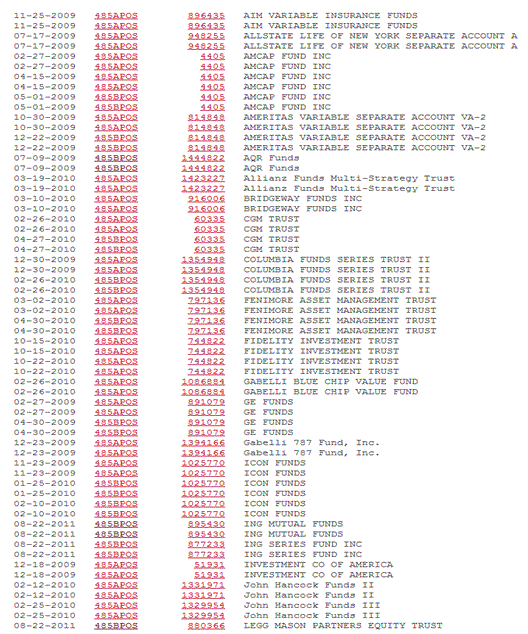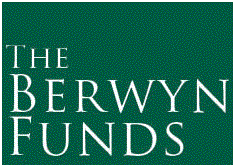Dear friends,
Almost all of the poems about the end of summer and beginning of fall are sad, wistful things. They’re full of regrets about the end of the season of growth and crammed with metaphors for decline, decay, death and despair.
It’s clear that poets don’t have investment portfolios.
The fact that benchmarks such as the Dow Jones Industrial average and Vanguard Total Bond Market are both showing gains for the year masks the trauma that has led investors to pull money out of long-term funds for six consecutive weeks. Whether having the greatest outflows since the market bottom in March 2009 is a good thing remains to be seen.

Roller coasters are funny things. They’re designed to scare the daylights out of you, and then deposit you back exactly where you started. It might be a sign of age (or, less likely, wisdom) that I’d really prefer a winding garden path or moving walkway to the thrills now on offer.
The Latest Endangered Species: Funds for Small Investors
Beginning in the mid-1990s, I maintained “The List of Funds for Small Investors” at the old Brill/Mutual Funds Interactive website. I screened for no-load funds with minimums of $500 or less and for no-load funds that waived their investment minimums for investors who were willing to start small but invest regularly. That commitment was made through an Automatic Investing Plan, or AIP.
At the time, the greatest challenge was dealing with the sheer mass of such funds (600 in all) and trying to identify the couple dozen that were best suited to new investors trying to build a solid foundation.
Over the years, almost all of those funds ceased to be “funds for small investors.” Some closed and a fair number added sales loads but the great majority simply raised their investment minimums. In the end, only one major firm, T. Rowe Price, persevered in maintaining that option.
And now they’re done with it.
Effective on August 1, Price eliminated several policies which were particularly friendly to small investors. The waiver of the minimum investment for accounts with an Automatic Asset Builder (their name for the AIP) has been eliminated. Rather than requiring a $50 minimum and $50/month thereafter, AAB accounts now require $2500 minimum and $100/thereafter.
The minimum subsequent investment on retail accounts was raised from $50 to $100.
The small account fee has been raised to $20 per account under $10,000. The fee will be assessed in September. You can dodge the fee by signing up for electronic document delivery.
Price changed the policies in response to poor behavior on the part of investors. Too many investors started with $50, built the account to $300 and then turned off the asset builder. Price then had custody of a bunch of orphaned accounts which were generating $3/year to cover management and administrative expenses. It’s not clear how many such accounts exist. Bill Benintende, one of Price’s public relations specialists, explains “that’s considered proprietary information so it isn’t something we’d discuss publicly.” This is the same problem that long-ago forced a bunch of firms to raise their investment minimums from $250- 500 to $2500.
Two groups escaped the requirement for larger subsequent investments. Mr. Benintende says that 529 college savings plans remain at $50 and individuals who already have operating AAB accounts with $50 investments are grandfathered-in unless they make a change (for example, switching funds or even the day of the month on which an investment occurs).
That’s a real loss, even if a self-inflicted one, for small investors. Nonetheless, there remain about 130 funds accessible to folks with modest budgets and the willingness to make a serious commitment to improving their finances. By my best reading, there are thirteen smaller fund families and a half dozen individual funds still taking the risk of getting stiffed by undisciplined investors. The families willing to waive their normal investment minimums are:
| Family | AIP minimum | Notes |
| Ariel | $50 | Four value-oriented, low turnover funds with the prospect of a fifth (international) fund in the future. |
| Artisan | $50 | Eleven uniformly great, risk-conscious equity funds. Artisan tends to close their funds early and a number are currently shuttered. |
| Aston funds | $50 | A relatively new family, Aston has 26 funds covering both portfolio cores and a bunch of interesting niches. They adopted some venerable older funds and hired institutional managers to sub-advise the others. |
| Azzad | $50 | Two socially-responsible funds, one midcap and one (newer) small cap |
| Berwyn | $0 | Three funds, most famously Berwyn Income (BERIX), all above average, run by the small team. |
| Gabelli/GAMCO | $0 | On AAA shares, anyway. Gabelli’s famous, he knows it and he overcharges. That said, these are really solid funds. |
| Heartland | $0 | Four value-oriented small to mid-cap funds, from a scandal-touched firm. Solid to really good. |
| Homestead | $0 | Seven funds (stock, bond, international), solid to really good performance, very fair expenses. |
| Icon | $100 | 17 funds whose “I” or “S” class shares are no-load. These are sector or sector-rotation funds. |
| James | $50 | Four very solid funds, the most notable of which is James Balanced: Golden Rainbow (GLRBX), a quant-driven fund that keeps a smallish slice in stocks |
| Manning & Napier | $25 | The best fund company that you’ve never heard of. Fourteen diverse funds, all managed by the same team. |
| Parnassus | $50 | Six socially-responsible funds, all but the flagship Parnassus Fund (PARNX) currently earn four or five stars from Morningstar. I’m particularly intrigued by Parnassus Workplace (PARWX) which likes to invest in firms that treat their staff decently. |
| USAA | $50 | USAA primarily provides financial services for members of the U.S. military and their families. Their funds are available to anyone but you need to join USAA (it’s free) in order to learn anything about them. That said, 26 funds, so quite good. |
There are, in addition, a number of individual funds with minimums reduced or waived for folks willing to commit to an automatic investment. Those include Barrett Opportunity (SAOPX), Cullen High Dividend Equity (CHDEX), Giordano (GIORX), Primary Trend (PTFDX), Sector Rotation (NAVFX), and Stonebridge Small Cap Growth (SBAGX).
On a related note: Fidelity would like a little extra next year
Fidelity will begin charging an “annual index fund fee” of $10.00 per fund position to offset shareholder service costs if your fund balance falls below $10,000, effective December 2011. They’re using the same logic: small accounts don’t generate enough revenue to cover their maintenance costs.
The Quiet Comeback of Artisan Small Cap (ARTSX)
The second fund in which I ever invested (AIM Constellation was the first) was Artisan Small Cap (ARTSX). Carlene Murphy Ziegler had been a star manager at Stein, Roe and at Strong. With the support of her husband, Andrew, she left to start her own fund company and to launch her own fund. Artisan Small Cap was a solid, mild-manned growth-at-a-reasonable price creature that drew a lot of media attention, attracted a lot of money, helped launch a stellar investment boutique, and quickly closed to new investors.
But, somewhere in there, the fund got out of step with the market. Rather than being stellar, it slipped to okay and then “not too bad.” It had some good years and was never terrible, but it also never managed to have two really good years back-to-back. The firm added co-managers including Marina Carlson, who had worked so successful with Ziegler at the Strong Funds. Ziegler stepped aside in 2008 and Carlson in 2009.
At that point, manager responsibilities were given to Andrew Stephens and the team that runs Artisan Mid Cap Fund (ARTMX). ARTMX has posted remarkably strong, consistent results for over a decade. It’s been in the top 10-15% of midcap growth funds for the past 1, 3, 5 and 10 year periods. It has earned four or five star ratings from Morningstar for the past 3, 5, and 10 year periods.
Since taking over in October 2009, ARTSX has outperformed its peers. $10,000 invested on the day the new team arrived would have gain to $13,900, compared to $13,100 at its peers. Both year to date and for the three, turbulent summer months, it’s in the top 2% of small growth funds. It has a top 5% record over the past year and top 15% over the past three.
Artisan has a very good record of allowing successful teams to expand their horizons. Scott Satterwhite’s team from Artisan Small Cap Value (ARTVX) inherited Artisan Mid Cap Value (ARTQX) and the large cap Artisan Value (ARTLX) funds, and has reproduced their success in each. The same occurred with the Artisan International Value team running Artisan Global Value and Artisan International running Artisan International Small Cap.
Given that track record and the fund’s resurgence under the Stephen’s team, it might be time to put Artisan Small Cap back on the radar.
Fund Update: RiverPark Short-Term High Yield

We profiled RPHYX in July as one of the year’s most intriguing new funds. It’s core strategy – buying, for example, called high yield bonds – struck me “as a fascinating fund. It is, in the mutual fund world, utterly unique . . . And it makes sense. That’s a rare and wonderful combination.”
The manager, David Sherman of Cohanzick Management, has been in remarkably good spirits, if not quite giddy, because market volatility plays into the fund’s strengths. There are two developments of note.
The manager purchased a huge number of additional shares of RPHYX after the market rout on Monday, August 8. (An earlier version of this note, on the Observer’s discussion board, specified an amount and he seemed a bit embarrassed by the public disclosure so I’ve shifted to the demure but accurate ‘huge number’ construction.)
The fund’s down about 0.4% since making its monthly distribution (which accounts for most of its NAV changes). For those keeping score, since August 1, Fidelity Floating Rate High Income (FFHRX, a floating-rate loan fund that some funds here guessed would parallel RiverPark) is down 4%, their new Global High-Income fund (FGHNX) is down 5% and Fidelity High Income (SPHIX) is down 4.5%.
Fortunately, the fund generates huge amounts of cash internally. Because durations are so short, he’s always got cash from the bonds which are being redeemed. When we spoke on August 10th, he calculated that if he did nothing at all with the portfolio, he’d get a 6% cash infusion on August 16, a 10% infusion on August 26th, and cash overall would reach 41% of the portfolio in the next 30 days. While he’s holding more cash than usual as a matter of prudent caution, he’s also got a lot to buy with.
And the market has been offering a number of exceptional bargains. He pointed to called HCA bonds which he first bought on July 27 at a 3.75% annualized yield. This week he was able to buy more at a 17% yield. Since the bonds would be redeemed at the end of August by a solidly-profitable company, he saw very little risk in the position. Several other positions (Las Vegas Sands public preferred and Chart Industries convertibles) have gone from yielding 3-3.5% to 5-6% available yields in the last two weeks.
He was also shortening up the portfolio to take advantage of emerging opportunities. He’s selling some longer-dated bonds which likely won’t be called in order to have more cash to act on irrational bargains as they present themselves. Despite an ultra-short duration, the fund is now yielding over 5%. The Fed, meanwhile, promises “near zero” interest rates for the next two years.
Mr. Sherman was at pains to stress that he’s not shilling for the fund. He doesn’t want to over-promise (this is not the equivalent of a savings account paying 5%) and he doesn’t want to encourage investors to join based on unrealistic hopes of a “magic” fund, but he does seem quite comfortable with the fund and the opportunity set available to him.
Note to the Securities and Exchange Commission: Hire a programmer!
Every day, the SEC posts all of its just-received filings online and every day I read them. (Yep. Really gotta get a life.) Here is a list of all of today’s prospectus filings. In theory, if you visit on September 1st and click on “most recent,” you’ll get a screen full of filings dated September 1st.
Except when you don’t. Here, for example, is a screen cap of the SEC new filings for August 22, 2011:

Notice how very far down this list you have to go before finding even one filing from August 22nd (it’s the ING Mutual Funds listing). On July 25th, 43 of 89 entries were wrong (including one originally filed in 2004).
Two-thirds of all Wall Street trades emanate from high-frequency traders, whose computers execute trades in 250 microseconds (“Not So Fast,” The Economist, 08/06/11). Those trades increase market volatility and asset correlations, to the detriment of most investors. The SEC’s difficulty in merely getting the date right on their form postings doesn’t give me much confidence in their ability to take on the problems posed by technology.
Four Funds, and why they’re worth your time
Really worth it. Every month the Observer profiles two to four funds that we think you really need to know more about. They fall into two categories:
Most intriguing new funds: good ideas, great managers. These are funds that do not yet have a long track record, but which have other virtues which warrant your attention. They might come from a great boutique or be offered by a top-tier manager who has struck out on his own. The “most intriguing new funds” aren’t all worthy of your “gotta buy” list, but all of them are going to be fundamentally intriguing possibilities that warrant some thought. This month’s two new funds:
RiverPark/Wedgewood (RWGFX): David Rolfe makes it seem so simple. Identify great companies, buy only the best of them, buy only when they’ve on sale, and hold on. For almost 19 years he’s been doing to same, simple thing – and doing it with unparalleled consistency and success. His strategy is now available to retail investors.
Walthausen Select Value (WSVRX): the case for this focused small- to mid-cap fund is simple. Manager John Walthausen has performed brilliantly with the last three funds he’s run and his latest fund seeks to build on one of those earlier models.
Stars in the shadows: Small funds of exceptional merit. There are thousands of tiny funds (2200 funds under $100 million in assets and many only one-tenth that size) that operate under the radar. Some intentionally avoid notice because they’re offered by institutional managers as a favor to their customers (Prospector Capital Appreciation and all the FMC funds are examples). Many simply can’t get their story told: they’re headquartered outside of the financial centers, they’re offered as part of a boutique or as a single stand-alone fund, they don’t have marketing budgets or they’re simply not flashy enough to draw journalists’ attention. There are, by Morningstar’s count, 75 five-star funds with under $100 million in assets; Morningstar’s analysts cover only eight of them.
The stars are all time-tested funds, many of which have everything except shareholders.
Northern Global Tactical Asset Allocation (BBALX): up until August 1st, you could access to the best ideas of Northern Investment Policy Committee only if you had $5 million to meet this fund’s minimum or $500 million in assets at Northern. And then it became a retail fund ($2500) with an institutional pedigree and expenses (0.68%). Folks looking for a conservative core fund just stumbled onto a really solid option.
Walthausen Small Cap Value (WSCVX): we profiled this fund shortly after launch as one of the year’s best new funds. Three years on, it’s running rings around its competition and starting to ask about when it will be necessary to close to new investors. A somewhat volatile choice, it has produced remarkable results.
Briefly noted . . .

Berwyn Income (BERIX) will reopen to new investors on Sept. 19. The $1.3 billion fund closed in November 2010, but says the board, “recent volatility in the market has led to new investment opportunities for the Fund.” BERIX makes a lot of sense in turbulent markets: modest stake in dividend-paying stocks and REITs, plus corporate bonds, preferred shares, convertibles and a slug of cash. Lots of income with some prospect for capital growth. The fund more than doubled in size between 2008 and 2009, then doubled in size again between 2009 and 2010. At the end of 2008, it was under $240 million. Today it carries a billion more in heft. Relative performance has drifted down a bit as the fund has grown, but it remains really solid.
Fidelity is bringing out two emerging market funds in mid-October. The less interesting, Emerging Markets Discovery, will be their small- to mid-cap fund. Total Emerging Markets will be a 60/40 balanced fund. The most promising aspect of the balanced fund is the presence of John Carlson, who runs New Markets Income (FNMIX) at the head of the management team. FNMIX has a splendid long-term record (Carlson’s been there for 16 years) but it’s currently lagging because it focuses on dollar-denominated debt rather than the raging local currency variety. Carlson argues that local currencies aren’t quite the safe haven that newbies believe and that, in any case, they’re getting way overvalued. He’ll have a team of co-managers who, I believe, run some of Fidelity’s non-U.S. funds. Fido’s emerging markets equity products have not been consistently great, so investors here might hope for index-like returns and a much more tolerable ride than a pure equity exposure would offer. The opening expense ratio will be 1.4% and the minimum investment will be $2500.
Northern Funds are reducing the operating expenses on all of their index funds, effective January 1, 2012. The seven funds involved are:
| Reduction and resulting expense ratio | |
| Emerging Market Equity | Reduced by 42 basis points, to 0.30% |
| Global Real Estate | 15 basis points, to 0.50% |
| Global Sustainability | 35 basis points, to 0.30% |
| International Equity | 20 basis points, to 0.25% |
| Mid Cap | 15 basis points, to 0.15% |
| Small Cap | 20 basis points, to 0.15% |
| Stock | 15 basis points, to 0.10% |
Nicely done!
Forward Management introduced a new no-load “investor” share class for Forward International Real Estate Fund (FFIRX), the Forward Real Estate Long/Short Fund (FFSRX), and the Forward Global Infrastructure Fund (FGLRX). Forward Real Estate (FFREX) already had a no-load share class. The funds are, on whole, respectable but not demonstrably great. The minimum investment is $4,000.
DWS Strategic Income (KSTAX) becomes DWS Unconstrained Income on Sept. 22, 2011. At that point, Philip Condon will join the management team of the fund. “Unconstrained” is the current vogue term for income funds, with PIMCO leading the pack by offering unconstrained Bond (also packaged as Harbor Unconstrained Bond), Tax-Managed Bond and Fixed Income funds. All of them have been underperformers in their short lives, suggesting that the ability to go anywhere doesn’t immediately translate into the wisdom to go somewhere sensible.
Litman Gregory Asset Management has renamed its entire line of Masters’ Select funds as Litman Gregory Masters Funds name.
PIMCO Developing Local Markets (PLMIX) has changed its name to PIMCO Emerging Markets Local Currency, presumably to gain from the “local currency debt” craze.
Dreyfus S&P Stars Opportunities (BSOBX) will change its name to Dreyfus MidCap Core on Nov. 1, 2011.
DWS RREEF Real Estate Securities (RRRRX) will close Sept. 30, 2011.
JPMorgan U.S. Large Cap Core Plus (JLCAX) closed to new investors on Sept. 2, 2011.
Scout TrendStar Small Cap (TRESX) is merging into Scout Small Cap (UMBHX).
MFS Core Growth (MFCAX) merged into MFS Growth (MFEGX) in August.
Effective Sept. 15, 2011, GMO Global Balanced Asset Allocation Fund (GMWAX) will be renamed GMO Global Asset Allocation Fund and it will no longer be bound to keep at least 25% each in stocks and bonds.
Forward Funds is changing Forward Large Cap Equity (FFLAX), a mild-mannered fund with a slight value bias, into Forward Large Cap Dividend Fund. After November 1, at least 80% of the portfolio will be in . . . well, large cap, dividend-paying stocks. Not to rain on anybody’s parade, but all of its top 25 holdings are already dividend-paying stocks which implies marketing rather than management drove the change.
Likewise, Satuit Capital Micro Cap has been changed to the Satuit Capital U.S. Emerging Companies Fund (SATMX). The Board hastened to assure shareholders that the change was purely cosmetic: “there are no other changes to the Fund being contemplated as a result of this name change.” Regardless, it’s been a splendid performer (top 1% over the past decade) with an elevated price tag (1.75%)
DWS Climate Change (WRMAX) becomes DWS Clean Technology on October 1, 2011.
A few closing notes . . .

We’re very pleased to announce the launch of The Falcon’s Eye. Originally written by a FundAlarm board member, Falcon, the Eye provides a quick and convenient link to each of the major profiles for any particular fund. Simply click on “The Falcon’s Eye” link on the main menu bar atop this page and enter one or more ticker symbols. A new windows pops up, giving the fund name and direct links to ten major source of information:
| Yahoo | Morningstar | |
| Smart Money | U.S. News | Barron’s |
| Bloomberg | USA Today | MSN |
And, of course, the Observer itself.
Mark whichever sources interest you, click, and the Eye will generate direct links to that site’s profile of or reporting on your fund. Thanks to Accipiter for his tireless work on the project, and to Chip, Investor, Catch22 and others for their support and beta testing of it. It is, we think, a really useful tool for folks who are serious about understanding their investments.
Thanks to all of you for using or sharing the Observer’s link to Amazon.com, which is providing a modest but very steady revenue stream. Special thanks for the folks who’ve chosen to contribute to the Observer this month and, especially, to the good folks at Milestones Financial Planning in Kentucky for their ongoing support. We’re hoping for a major upgrade in the site’s appearance, in addition to the functionality upgrades that Chip and Accipiter have worked so faithfully on.
Looking for the archive? There is an archive of all Observer and later FundAlarm commentaries, links to which usually appear at the top of this page. This month we encountered a software glitch that was scrambling the list, so we’ve temporarily hidden it. Once out tech folks have a chance to play with the code, it’ll be back where it belongs. Thanks for your patience!
Keep those cards and letters, electronic or otherwise, coming. I love reading your thoughts.
See you in October!
David
